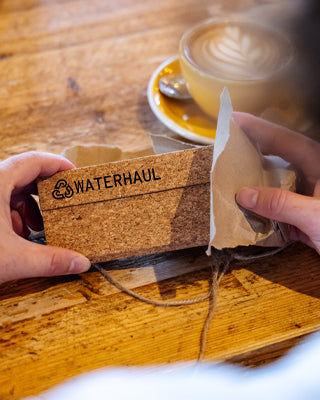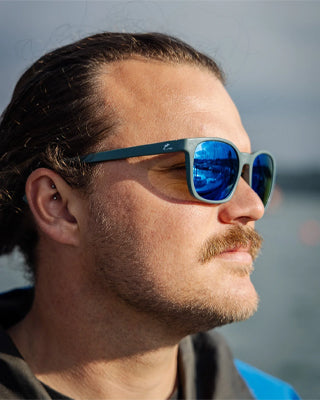
Harry Dennis
November 25, 2025
Rope Recycling in the UK: Challenges, Solutions, and Waterhaul’s Mission
Our guide to recycling solutions for fishing, aquaculture, marine and other forms of ropes and lines.
Waterhaul is the UK's leading recycler of marine ropes and lines (alongside nets). Our mission is to create a circular economy solution to this waste in the UK and Ireland, preventing these materials from ending up in landfill or impacting our marine environments. We've developed a unique process for recycling marine-sourced ropes and lines at scale in the UK, with a particular emphasis on polypropylene and polyethylene fibre ropes, and tranforming this into our Traceable Marine Plastic™ material.
While ropes are essential for industries like fishing, aquaculture, and shipping, they pose significant challenges when it comes to recycling and disposal—especially as most are now made from durable synthetic plastics. In this article, we’ll explain:
• The challenges of recycling ropes
• Different types of ropes and materials
• How Waterhaul recycles marine ropes
• The scale of the rope waste in the UK
• How you or your business can recycle ropes responsibly.
Why Rope Recycling is Currently Such a Challenge
Modern synthetic ropes are made from fine fibres of plastic. These plastic fibres are braided and woven tightly to create strength and durability, but this same form poses specific challenges to deal with at the end of their life, and combined with high levels of contamination, has historic resulted in extremely low recycling rates which the vast majority of ropes ending in landfill or incineration.
These challenges present themselves at all stages of the recycling process. For example, fine fibres can clog and damage machinery during shredding and ropes have a tendancy to wrap and tie around rotor blades. Specialist machinery is required, whereas most plastic recycling plants are designed to deal with houseplastic plastics and rigid plastics. Once shredded, the resulting material is incredibly light and bulky and lacks the density to flow through hoppers and be processed by standard machinery.
These difficulties continue in the washing stage. Ropes hold far more contamination, such as sand, salt, and biological matter like algae, and can be exposes to other contaminants such as oils, all of which can affect processing. Manual sorting and seperation is also required to isolate different polymers. Many of these challenges mirrors issues in textile recycling but is further exacerbated in marine ropes due to the extreme contamination from ocean use.
Types of Ropes and Their Impact
1. Polypropylene (PP) Ropes
• Usage: Very common in lines for fishing nets, potting lines, general purposes ropes and ship mooring lines.
• Impact: PP ropes are the most common in the UK’s fishing and aquaculture industry. We estimate that 1,500 tonnes of polypropylene rope waste are generated annually by the UK's fishing and aquaculutre secter annual.
2. Polyethylene (PE / HDPE) Ropes
• Usage: Various marine and aquaculture applications. Also commonly used in nets.
• Impact: Similar to PP ropes but often harder to process due to thicker fibres.
3. Polyester Ropes
• Usage: Sailing lines and industrial ropes.
• Impact: Polyester is denser and heavier than PP or PE ropes, making it sink in marine environments, which has the potential to pollute seabed habitats
4. Nylon Ropes
• Usage: Ship mooring lines and industrial ropes.
• Impact: Nylon is also denser and heavier than PP or PE ropes, making it sink in marine environments.
4. Dyneema Ropes
• Usage: High-performance ropes for sailing, towing, and industrial settings. • Impact: Dyneema ropes are ultra-durable and are a form of polyethylene however they require specialised processes to recycle due to their ultra high molecular weight composition.
5. Lead-Cored or Lead-Lined Ropes
Lead-core ropes contain integrated lead weights for sinking and stability, but they present a major recycling challenge:
• Hazardous Processing: The lead core is dangerous to handle and recycle.
• No Current Solution: At present, there is no safe, scalable recycling solution for these ropes.
• Future Innovation: Waterhaul is exploring chemical recycling to address this challenge and advocates for design for circularity—encouraging rope manufacturers to use external, removable lead weights instead of integrated cores.
6. Other Ropes: Climbing and Other Specialty Ropes
Climbing ropes and other niche ropes (e.g., paragliding lines) are often made from mixed materials, such as nylon and polyester.
While Waterhaul primarily focuses on marine, fishing and aquaculture ropes, we do have the technical ability to recycle other sources of polypropylene ropes. Please contact us if you have a high volume (over 10/tonnes annum) request.

From Natural Fibres to Synthetic Ropes: A Turning Point
Historically, ropes were made from natural fibres like hemp, sisal, and jute. These materials biodegraded naturally, posing minimal risk if lost at sea.
However, with the advent of synthetic plastic ropes (e.g., polypropylene, nylon), the issue has become far more severe. Modern ropes are:
• Non-biodegradable: Synthetic fibres persist for hundreds of years, causing long-term pollution.
• A Major Threat as Ghost Gear: Lost or abandoned ropes entangle marine animals and damage ecosystems.
This shift has transformed ropes into an environmental problem that requires urgent action.
How Waterhaul Recycles Marine Ropes
Recycling ropes requires specialised processes to handle their unique structure and contamination. At Waterhaul, our main recycling focus is on polypropylene and polyethylene (HDPE) marine and fishing ropes, as these are the most common forms and the most frequently found as ghost gear or marine litter. However, we do have experience of processing other forms such as polyester and nylon. Our recycling process is done using the following steps:
1. Collection
We recover end-of-life ropes through our own collections and through partnerships with fishers, harbours, aquaculture operators, waste management companies such as BIFFA and conservation groups across the UK. We have hubs located in Cornwall and Scotland (opening 2026). We also accept ropes from individuals seeking sustainable disposal options.
2. Sorting and Cleaning
Ropes are manually sorted by polymer type, disassembled from any attached materials and pre-cleaned to remove contaminants like biological material, sand and metals.
3. Shredding / Desizing
Shredding marine ropes is challenging due to their fine fibres, but we use specialised equipment to break them down into smaller pieces.
4. Processing
The shredded material is melted, extruded and pelletised into our Traceable Marine Plastic; a high-quality plastic granulate, ready for reuse.
5. Repurposing
We repurpose the recycled material into durable products, supporting a circular economy and reducing plastic waste.

How To Recycle Your Marine Ropes
If you’re looking for a responsible way to recycle your ropes, Waterhaul is here to help. Whether you’re a fisher, harbour or aquaculture facility manager, or outdoor enthusiast, we can provide recycling solutions.
What We Accept
• Polypropylene (PP) and polyethylene (PE) ropes with a fishing, aquaculture or marine origin.
• Recovered beach clean / ghost gear ropes.
• Nylon, polyester, and dyneema may be considered on a case-by-case basis; please contact us.
How to Recycle Ropes
• Contact Us: Reach out via our contact page to discuss your rope recycling needs.
• Arrange Collection or Drop-Off: Depending on your location and the quantity of ropes, we’ll help arrange logistics.
• Collaborate with Us: We work with businesses and communities to implement sustainable rope recycling solutions.

The Bigger Picture: Why Rope Recycling Matters
- • Prevents Pollution: Recycled ropes are kept out of landfills and most importantly our oceans where they can become a risk to marine life as ghost gear.
- Creates a Circular Economy: By transforming waste into resources, we're contributing to a more circular and sustainable economic model.
- Reduces Costs For All: Landfilling is expensive, creating a financial burden on proper disposal. Recycling ropes is not only more cost efficient, but also allows for value to be unlocked from this 'waste' creating new products, jobs and opportunities.
At Waterhaul, we estimate that addressing just the 1,500 tonnes of marine polypropylene rope waste generated annually in the UK could make significant progress in resource efficiency and reducing marine plastic pollution.
Looking to the Future: Innovation and Circular Design
Waterhaul is committed to developing new solutions for rope recycling, including tackling challenges like lead-lined ropes through chemical recycling. Additionally, we’re urging manufacturers to design for circularity, such as using external, removable lead weights instead of integrated cores.


